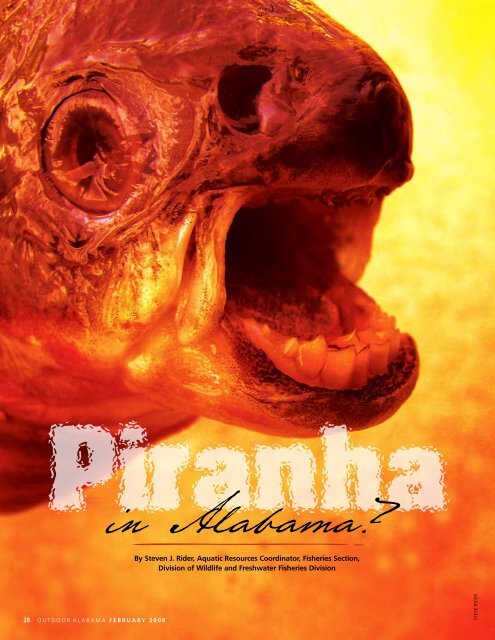Piranha in Alabama? - Alabama Department of Conservation and ...
Piranha in Alabama? - Alabama Department of Conservation and ...
Piranha in Alabama? - Alabama Department of Conservation and ...
Create successful ePaper yourself
Turn your PDF publications into a flip-book with our unique Google optimized e-Paper software.
<strong>Piranha</strong><br />
<strong>in</strong> <strong>Alabama</strong>?<br />
By Steven J. Rider, Aquatic Resources Coord<strong>in</strong>ator, Fisheries Section,<br />
Division <strong>of</strong> Wildlife <strong>and</strong> Freshwater Fisheries Division<br />
28 Outdoor alabama february 2008<br />
Steve Rider
What’s the first th<strong>in</strong>g you th<strong>in</strong>k <strong>of</strong> when you hear a “piranha”<br />
has just been caught at your local fish<strong>in</strong>g or swimm<strong>in</strong>g hole? Do<br />
thoughts <strong>of</strong> ravenous fish eat<strong>in</strong>g everyth<strong>in</strong>g <strong>in</strong> sight enter your head? Do<br />
you wonder if you can ever go <strong>in</strong>to the water aga<strong>in</strong>?<br />
These concerns have been expressed <strong>in</strong> recent years due to the alleged<br />
catch <strong>of</strong> “piranha” <strong>in</strong> the public waters <strong>of</strong> <strong>Alabama</strong>. Several articles <strong>in</strong><br />
local newspapers have been quick to report the catch <strong>of</strong> a piranha <strong>in</strong> their<br />
area. However, to date, there has been no confirmed catches <strong>of</strong> piranha <strong>in</strong><br />
<strong>Alabama</strong> public waters. So what was caught? All catches brought to the<br />
attention <strong>of</strong> fisheries biologists with the <strong>Alabama</strong> Wildlife <strong>and</strong> Freshwater<br />
Fisheries Division have been verified as pacu.<br />
What Is Pacu?<br />
Pacu (Colossoma spp. or Piaractus spp.)<br />
refers to several species <strong>of</strong> fishes native<br />
to South America that are closely related<br />
to piranha. Pacu are ma<strong>in</strong>ly herbivores<br />
consum<strong>in</strong>g plant matter, seeds, nuts, <strong>and</strong><br />
fruit; however, they will eat small fish <strong>and</strong><br />
<strong>in</strong>sects. This expla<strong>in</strong>s why anglers catch<br />
pacu <strong>in</strong> <strong>Alabama</strong> with m<strong>in</strong>nows, live <strong>and</strong><br />
plastic baits. While taxonomists debate on<br />
the number <strong>of</strong> piranha species (also native<br />
to South America), the true piranhas (Pristobrycon<br />
spp., Pygocentrus spp., Pygopristis<br />
spp., <strong>and</strong> Serrasalmus spp.) are considered<br />
carnivores consum<strong>in</strong>g fish <strong>and</strong> animal flesh.<br />
Tell<strong>in</strong>g the Difference<br />
How do you tell the difference between a<br />
piranha <strong>and</strong> a pacu? <strong>Piranha</strong> <strong>and</strong> pacu have<br />
similar coloration <strong>and</strong> body shapes, hence<br />
the confusion. The simplest way<br />
is by look<strong>in</strong>g at the teeth.<br />
Yes, you must look at<br />
the teeth! Us<strong>in</strong>g a pen,<br />
slowly pry open the<br />
jaw. Be careful not to<br />
touch the teeth until<br />
you are certa<strong>in</strong> it is a<br />
pacu. True piranhas<br />
have a s<strong>in</strong>gle row <strong>of</strong> very<br />
sharp triangularshaped<br />
teeth <strong>in</strong><br />
the lower <strong>and</strong><br />
PacU<br />
upper jaws with a pronounced underbite.<br />
These teeth are obviously best suited<br />
for shear<strong>in</strong>g <strong>and</strong> tear<strong>in</strong>g flesh. Pacu have<br />
molar-like or somewhat square-shaped<br />
straight teeth <strong>in</strong> a less underbite to a<br />
slight overbite. This type <strong>of</strong> dentation is<br />
used for crush<strong>in</strong>g plant matter<br />
<strong>and</strong> seeds.<br />
PIRANHA<br />
Illegal Release<br />
How does a pacu f<strong>in</strong>d its way <strong>in</strong>to<br />
<strong>Alabama</strong>’s public waters? These fish are<br />
released by aquarists because their pet has<br />
outgrown its tank. When first sold, these<br />
species are usually 2-3 <strong>in</strong>ches; however, they<br />
can quickly grow to 30 <strong>in</strong>ches. The most<br />
common pacu species sold <strong>in</strong> pet stores are<br />
the red-bellied <strong>and</strong> black pacus. Both <strong>of</strong><br />
these species have been found <strong>in</strong> <strong>Alabama</strong><br />
public waters. Instead <strong>of</strong> properly dispos<strong>in</strong>g<br />
or search<strong>in</strong>g for a larger aquarium, some<br />
aquarists decide to release their overgrown<br />
pacu <strong>in</strong>to the local public lake or river. This<br />
is illegal due to the harm that non-native<br />
aquatic species can cause to native aquatic<br />
species. The release or stock<strong>in</strong>g without<br />
an approved permit from the <strong>Alabama</strong><br />
<strong>Department</strong> <strong>of</strong> <strong>Conservation</strong> <strong>and</strong> Natural<br />
Resources <strong>of</strong> any fish, mussel, snail or<br />
crayfish <strong>in</strong>to the public waters <strong>of</strong> <strong>Alabama</strong><br />
is illegal. Non-native aquatic species<br />
can outcompete the native aquatic<br />
species for food <strong>and</strong> habitat <strong>and</strong><br />
may <strong>in</strong>troduce exotic parasites<br />
<strong>and</strong> diseases.<br />
<strong>Piranha</strong> (bottom photo)<br />
with sharp, triangularshaped<br />
teeth <strong>and</strong> pacu<br />
(top photo) with<br />
straight, molarlike<br />
teeth.<br />
Steve Rider<br />
What do you do with your overgrown or<br />
unwanted aquarium fishes? The follow<strong>in</strong>g<br />
are alternatives to release as responsible<br />
environmental stewards:<br />
n<br />
n<br />
n<br />
n<br />
n<br />
Contact your pet retailer for possible<br />
return or exchange.<br />
Give or trade with other aquarist.<br />
Donate to local aquarium society,<br />
zoo, or school.<br />
Contact veter<strong>in</strong>arian or pet retailer for<br />
guidance on humane disposal.<br />
If you cannot f<strong>in</strong>d a home for your fishes,<br />
bury them. Dump the water<br />
<strong>in</strong>to the toilet or yard, far away<br />
from storm dra<strong>in</strong>s.<br />
Species Regulation<br />
Why have no piranha been caught like<br />
pacu <strong>in</strong> <strong>Alabama</strong>? This can be expla<strong>in</strong>ed<br />
by the prohibited species regulation <strong>and</strong><br />
enforcement <strong>of</strong> this regulation by conservation<br />
<strong>of</strong>ficers with the <strong>Alabama</strong> Wildlife<br />
<strong>and</strong> Freshwater Fisheries Division. For any<br />
piranha it is illegal to “possess, sell, <strong>of</strong>fer for<br />
sale, import, br<strong>in</strong>g or cause to be brought<br />
or imported <strong>in</strong>to the state <strong>of</strong> <strong>Alabama</strong>.”<br />
Moreover, through the diligent efforts <strong>of</strong><br />
our conservation <strong>of</strong>ficers, they have been<br />
able to confiscate <strong>and</strong> make successful cases<br />
for the possess<strong>in</strong>g <strong>and</strong> import<strong>in</strong>g <strong>of</strong> piranha<br />
<strong>in</strong> <strong>Alabama</strong>.<br />
These efforts have helped to prevent any<br />
un<strong>in</strong>tentional or <strong>in</strong>tentional release <strong>of</strong> piranha<br />
<strong>in</strong> <strong>Alabama</strong>’s public waters. However,<br />
we cannot solely rely on conservation <strong>of</strong>ficers<br />
to protect <strong>Alabama</strong>’s aquatic resources.<br />
All citizens must consider their actions <strong>and</strong><br />
their affect on the unique aquatic resources<br />
<strong>of</strong> <strong>Alabama</strong>.<br />
For More Information<br />
www.habitattitude.net<br />
www.protectyourwaters.net<br />
www.<strong>in</strong>vasivespecies<strong>in</strong>fo.gov/aquatics<br />
Outdoor alabama february 2008 29

















